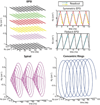Concentric rings K-space trajectory for hyperpolarized (13)C MR spectroscopic imaging
- PMID: 25533653
- PMCID: PMC4476971
- DOI: 10.1002/mrm.25577
Concentric rings K-space trajectory for hyperpolarized (13)C MR spectroscopic imaging
Abstract
Purpose: To develop a robust and rapid imaging technique for hyperpolarized (13)C MR Spectroscopic Imaging and investigate its performance.
Methods: A concentric rings readout trajectory with constant angular velocity is proposed for hyperpolarized (13)C spectroscopic imaging and its properties are analyzed. Quantitative analyses of design tradeoffs are presented for several imaging scenarios. The first application of concentric rings on (13)C phantoms and in vivo animal hyperpolarized (13)C MR Spectroscopic Imaging studies were performed to demonstrate the feasibility of the proposed method. Finally, a parallel imaging accelerated concentric rings study is presented.
Results: The concentric rings MR Spectroscopic Imaging trajectory has the advantages of acquisition timesaving compared to echo-planar spectroscopic imaging. It provides sufficient spectral bandwidth with relatively high efficiency compared to echo-planar spectroscopic imaging and spiral techniques. Phantom and in vivo animal studies showed good image quality with half the scan time and reduced pulsatile flow artifacts compared to echo-planar spectroscopic imaging. Parallel imaging accelerated concentric rings showed advantages over Cartesian sampling in g-factor simulations and demonstrated aliasing-free image quality in a hyperpolarized (13)C in vivo study.
Conclusion: The concentric rings trajectory is a robust and rapid imaging technique that fits very well with the speed, bandwidth, and resolution requirements of hyperpolarized (13)C MR Spectroscopic Imaging.
Keywords: concentric rings; hyperpolarized 13C; non-Cartesian trajectory; parallel imaging; spectroscopic imaging.
© 2014 Wiley Periodicals, Inc.
Figures









References
-
- Nelson SJ, Kurhanewicz J, Vigneron DB, Larson PEZ, Harzstark AL, Ferrone M, van Criekinge M, Chang JW, Bok R, Park I, Reed G, Carvajal L, Small EJ, Munster P, Weinberg VK, ArdenkjaerLarsen JH, Chen AP, Hurd RE, Odegardstuen LI, Robb FJ, Tropp J, Murray JA. Metabolic imaging of patients with prostate cancer using hyperpolarized [1-13c]pyruvate. Science Translational Medicine. 2013;5:198ra108. - PMC - PubMed
-
- Cunningham CH, Vigneron DB, Chen AP, Xu D, Nelson SJ, Hurd RE, Kelley DA, Pauly JM. Design of flyback echo-planar readout gradients for magnetic resonance spectroscopic imaging. Magnetic resonance in medicine. 2005;54:1286–1289. - PubMed
-
- Yen YF, Kohler S, Chen A, Tropp J, Bok R, Wolber J, Albers M, Gram K, Zierhut M, Park I, Zhang V, Hu S, Nelson S, Vigneron D, Kurhanewicz J, Dirven H, Hurd R. Imaging considerations for in vivo 13c metabolic mapping using hyperpolarized 13c-pyruvate. Magnetic Resonance in Medicine. 2009;62:1–10. - PMC - PubMed
Publication types
MeSH terms
Grants and funding
LinkOut - more resources
Full Text Sources
Other Literature Sources
Medical

